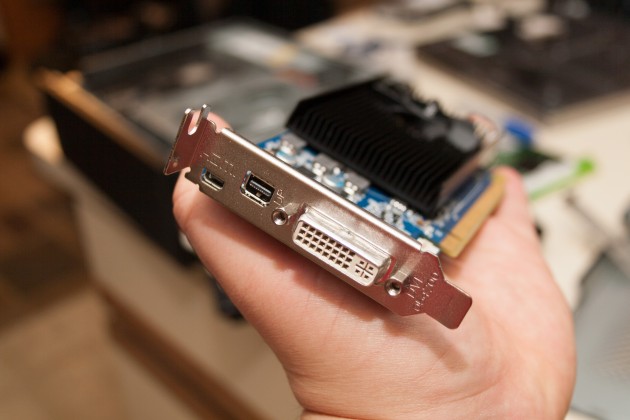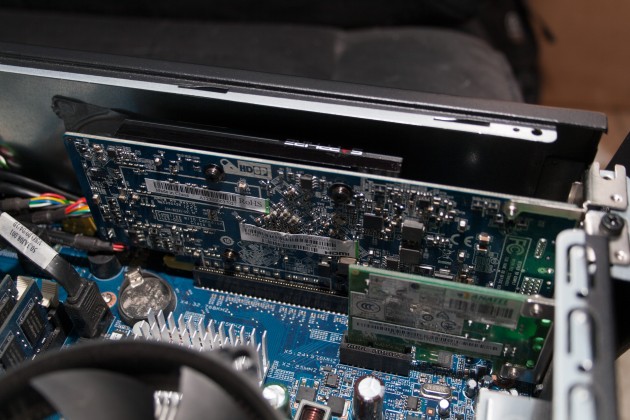Earlier this year we reviewed the SAPPHIRE Radeon HD 7750 Ultimate GPU. The “Ultimate” moniker comes from the advanced passive cooling that SAPPHIRE is famous for, allowing this affordable mid-range DirectX 11 GPU to be overclocked for higher performance than its price range would suggest. On top of that, it’s totally silent.
They’ve now released a low-profile version of the 7750, for Mini-ITX and HTPC applications. For those that want to build a tiny PC that can play games, this might be the card for you.
The SAPPHIRE Radeon HD 7750 Low Profile is the exact same Graphics Core Next “Southern Islands” GPU as the Ultimate (which we awarded our Silver Outstanding Product award to), but the form factor is considerably different. It’s too small to be passively cooled, so SAPPHIRE designed a single-slot low-profile heatsink and very quiet fan for this form factor.
The card comes in the box with a Mini-ITX bracket installed on it:
As you can see, out of the box it supports DVI, MiniDP, and Micro HDMI. It also comes with a MiniDP to DP adapter, a Micro HDMI to HDMI adapter, and a DVI to VGA adapter. With what’s included here, you will be able to hook it up to any possible display (okay, not composite or component, but come on, don’t be silly).
While this card fits perfectly in a normal PC and performs admirably for such an inexpensive card (see benchmark numbers in Nick’s 7750 Ultimate review—they’re unchanged), the real power of this little sucker is in upgrading a Mini-ITX PC to something that can play modern games, or as a fantastic Mini-ITX HTPC.
I just so happened to have the perfect patient for an upgrade operation: My parents’ old Acer Aspire X1300 from a few years back. It was getting a bit long in the tooth—good enough for grandma and grandpa, but when my kids were over their house for the weekend and wanted to play WoW, TF2, Battlefield 3, or League of Legends, the onboard NVIDIA GeForce 8200 didn’t really cut the mustard. Okay, it played WoW alright, but I think WoW can run on a refactored Dreamcast at this point, so that doesn’t say much.
The Acer is tiny, but it does contain a single PCI-E x16 slot, so I rubbed my hands together and got to work.
As you can see, the fit was very close. I plugged it in and turned it on and started installing drivers. After about five minutes of run time, I smelled burning electronics and, with the experience that only comes with years of building (and breaking) PCs, I immediately yanked the power cord—I knew that smell.
As it turns out, the front panel USB header cable was running between the GPU and the case, and it was rubbing up against the SAPPHIRE fan, preventing it from turning. The card got super hot (I didn’t measure it, but it was burning to the touch), but the system was running fine as if nothing was wrong.
I used duct tape to flatten the USB header cable against the case, allowing the fan to spin, and I went on my merry way, this time with the fan working properly.
The card idles at 39C, and under load got up to 46C. The single-slot fan, even with that tiny amount of clearance, worked well. An interesting aspect of the cooling setup is that the fan blows back into the case rather than out through venting slots on the cover. You may want to take that into consideration if space inside your small case isn’t vented properly elsewhere.
The Eyefinity thing
I can’t think of many people who will run five monitors from a low-profile GPU… especially since a budget that allows for five monitors probably allows for a high-end GPU to run them, but the fact is that the 7750 supports up to five monitors with Eyefinity.
When we reviewed the 7750 Ultimate, a Redditor took issue with the fact that we mentioned daisy-chaining with MST hubs, something AMD has been claiming their cards support for quite some time.
“AMD and its partners have been making claims about how many monitors their DP enabled cards can drive for literally 2 years now on the back of the DP spec’s support of Multi-Stream Transport (MST) hubs. They’ve announced the hardware as being available early last year, late last year, early this year, and now maybe mid this year, maybe. It’s vaporware. You cannot attach 5 displays to this or any other AMD card that hasn’t been specifically created for 5/6 displays (such as the Sapphire Flex line, and there aren’t any for the 7000 series). I say this as the owner of 3 120Hz DP connected displays and a pair of 7970s in crossfire. Because I can only drive two of them via DP (the other via HDMI), I cannot to 120Hz across the three of them, and thus cannot do HD3D across them.”
AMD’s Robert “Thrax” Hallock responded candidly,
“I actually work for AMD, in the GPU division, so I can give you some insight on what’s going on. AMD GPUs are designed with DP1.2 MST, as you are obviously aware. Any monitor or monitor hub that is also MST-aware will enable the end user to connect up to three DP monitors per DP output.
The holdup is with the people who are actually making the DP hubs. Silicon issues first prevented them from getting hubs that even worked. Then they sorta worked, but only if you connected cables in a certain order and then powered on the PC (no hotplugging). Then they made hubs that were about twice the size of a Boxee Box (huge). Now they’re in the process of miniaturization. We’ve been told we’ll see retail models by the summer of this year, and we demonstrated some at the press even we held for the 7900 Series in Austin in December.
The reality is that we’re at the mercy of the people who make the adapters, hubs and cables. We can push and pressure, but we can’t make someone else’s business do something any faster. We don’t make these kinds of products, so there’s no economy of scale to do it ourselves.”
That was his response five months ago. To see if things have changed since then, we again asked Hallock if MST hubs were available yet. His response:
Partners like Bizlink are still at the miniaturization stage of product development. Current beta units are approximately the size of a child’s lunchbox, but retail units are expected to be closer to the size of a USB hub. At last report, we are told they’ll finally be available in Q4 of this year.
 So there you have it. The card supports it, AMD doesn’t hide behind the fact that hubs are still unavailable, and it’s not really their fault.
So there you have it. The card supports it, AMD doesn’t hide behind the fact that hubs are still unavailable, and it’s not really their fault.
If you’re looking for a fairly capable GPU that can fit in a low-profile bracket in a Mini-ITX installation, the SAPPHIRE Radeon HD 7750 Low Profile is the card for you. The tiny size, the innovative cooling, and the always-great pack-ins that SAPPHIRE provides in the way of adapters and flexibility options all add up to a great package for enthusiasts in this price range. We’re happy to award this GPU the Icrontic Stamp of Approval.
The SAPPHIRE Radeon HD 7750 Low Profile GPU is available at NewEgg for $114.99














 Articles RSS
Articles RSS